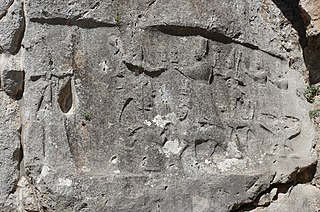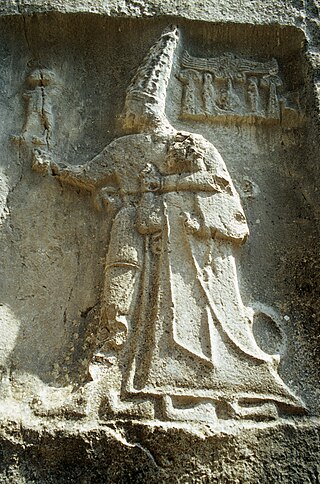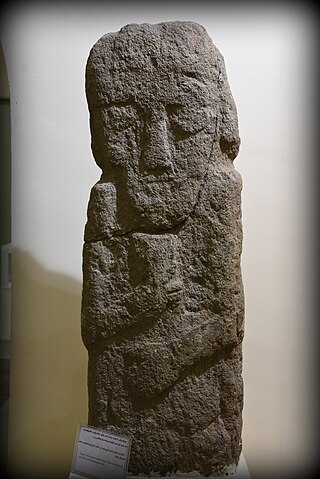Related Research Articles

The Hurrians were a people who inhabited the Ancient Near East during the Bronze Age. They spoke the Hurrian language, and lived throughout northern Syria, upper Mesopotamia and southeastern Anatolia.

Teshub was the Hurrian weather god, as well as the head of the Hurrian pantheon. The etymology of his name is uncertain, though it is agreed it can be classified as linguistically Hurrian. Both phonetic and logographic writings are attested. As a deity associated with the weather, Teshub could be portrayed both as destructive and protective. Individual weather phenomena, including winds, lightning, thunder and rain, could be described as his weapons. He was also believed to enable the growth of vegetation and create rivers and springs. His high position in Hurrian religion reflected the widespread importance of weather gods in northern Mesopotamia and nearby areas, where in contrast with the south agriculture relied primarily on rainfall rather than irrigation. It was believed that his authority extended to both mortal and other gods, both on earth and in heaven. However, the sea and the underworld were not under his control. Depictions of Teshub are rare, though it is agreed he was typically portrayed as an armed, bearded figure, sometimes holding a bundle of lightning. One such example is known from Yazılıkaya. In some cases, he was depicted driving in a chariot drawn by two sacred bulls.

Šarruma, also romanized as Šarrumma or Sharruma, was a Hurrian god. He could be depicted in both anthropomorphic form, sometimes riding on the back of a leopard, and in the theriomorphic form as a bull. His character is not fully understood, though it is known that he could function as a mountain god. He was regarded as a son of Ḫepat and Teshub. He was also linked to various moon deities. Additionally, the only mythological text he appears in addresses him as a messenger (sukkalu) of Kumarbi. He was worshiped by Hurrians in southeastern Anatolia and northern Syria, for example in Kummanni and Lawazantiya in Kizzuwatna. From this kingdom he was introduced to the Hittite pantheon as well. Hittite influence in turn resulted in his introduction to cities such as Aleppo, Emar and Ugarit. He was also venerated in Luwian religion in the first millennium BCE, with theophoric names invoking him attested from as late as the Hellenistic period in Cilicia and Lycia.

Ḫepat was a goddess associated with Aleppo, originally worshiped in the north of modern Syria in the third millennium BCE. Her name is often presumed to be either a feminine nisba referring to her connection to this city, or alternatively a derivative of the root ḫbb, "to love". Her best attested role is that of the spouse of various weather gods. She was already associated with Adad in Ebla and Aleppo in the third millennium BCE, and in later times they are attested as a couple in cities such as Alalakh and Emar. In Hurrian religion she instead came to be linked with Teshub, which in the first millennium BCE led to the development of a tradition in which she was the spouse of his Luwian counterpart Tarḫunz. Associations between her and numerous other deities are described in Hurrian ritual texts, where she heads her own kaluti, a type of offering lists dedicated to the circle of a specific deity. She commonly appears in them alongside her children, Šarruma, Allanzu and Kunzišalli. Her divine attendant was the goddess Takitu. In Hittite sources, she could sometimes be recognized as the counterpart of the Sun goddess of Arinna, though their respective roles were distinct and most likely this theological conception only had limited recognition. In Ugarit the local goddess Pidray could be considered analogous to her instead.
Kumarbi, also known as Kumurwe, Kumarwi and Kumarma, was a Hurrian god. He held a senior position in the Hurrian pantheon, and was described as the "father of gods". He was portrayed as an old, deposed king of the gods, though this most likely did not reflect factual loss of the position of the head of the pantheon in Hurrian religion, but only a mythological narrative. It is often assumed that he was an agricultural deity, though this view is not universally accepted and the evidence is limited. He was also associated with prosperity. It was believed that he resided in the underworld.

Nikkal or Nikkal-wa-Ib was a goddess worshiped in various areas of the ancient Near East west of Mesopotamia. She was derived from the Mesopotamian goddess Ningal, and like her forerunner was regarded as the spouse of a moon god, whose precise identity varied between locations. While well attested in Hurrian and Hittite sources, as well as in Ugarit, she is largely absent from documents from the western part of ancient Syria.

Muṣaṣir, in Urartian Ardini was an ancient city of Urartu, attested in Assyrian sources of the 9th and 8th centuries BC.

Šauška (Shaushka), also called Šauša or Šawuška, was the highest ranked goddess in the Hurrian pantheon. She was associated with love and war, as well as with incantations and by extension with healing. While she was usually referred to as a goddess and with feminine titles, such as allai, references to masculine Šauška are also known. The Hurrians associated her with Nineveh, but she was also worshiped in many other centers associated with this culture, from Anatolian cities in Kizzuwatna, through Alalakh and Ugarit in Syria, to Nuzi and Ulamme in northeastern Mesopotamia. She was also worshiped in southern Mesopotamia, where she was introduced alongside a number of other foreign deities in the Ur III period. In this area, she came to be associated with Ishtar. At a later point in time, growing Hurrian influence on Hittite culture resulted in the adoption of Šauška into the Hittite state pantheon.
Shubria or Shupria was a kingdom in the southern Armenian highlands, known from Assyrian sources in the first half of the 1st millennium BC. It was located north of the upper Tigris River and to the southwest of Lake Van, extending eastwards to the frontiers of Urartu. It appears in the 1st millennium BC as an independent kingdom, succeeding the people earlier called Shubaru in Assyrian sources in the later centuries of the 2nd millennium BC. It was located between the powerful states of Assyria and Urartu and came into conflict with both. It was conquered by Assyria in 673–672 BC but likely regained its independence towards the end of the 7th century BC with the collapse of Assyrian power.
Tilla or Tella was a Hurrian god assumed to have the form of a bull. He is best attested in texts from Nuzi, where he commonly appears in theophoric names. His main cult center was Ulamme.

Allani, also known under the Akkadian name Allatu, was the Hurrian goddess of the underworld. She was also associated with the determination of fate. She was closely linked with Ishara, and they could be invoked or receive offerings together. She also developed connection with other underworld deities from neighboring cultures, such as Mesopotamian Ereshkigal, Anatolian Sun goddess of the Earth and Lelwani, and possibly Ugaritic Arsay. It is presumed she was chiefly worshiped in western areas inhabited by the Hurrians, though the location of her main cult center is uncertain. She is attested in texts from sites such as Tigunani, Tuttul and Ugarit. She was also incorporated into the Mesopotamian pantheon, and was venerated in Ur, Nippur and Sippar. Hittite sources mentioning her are known too.
Šuwaliyat was a Hittite god associated with vegetation. He was worshiped in Kanesh, Ḫupišna and Ḫunḫuišna, as well as in Hattusa. In a number of ritual texts he appears alongside the grain goddess Ḫalki. A close connection between him and the Hurrian god Tašmišu is also attested, and in Hittite adaptations of Hurrian myths and in other texts reflecting Hurrian influence his name could be used to designate his Hurrian counterpart.

The Hurrian religion was the polytheistic religion of the Hurrians, a Bronze Age people of the Near East who chiefly inhabited the north of the Fertile Crescent. While the oldest evidence goes back to the third millennium BCE, it is best attested in cuneiform sources from the second millennium BCE written not only in the Hurrian language, but also Akkadian, Hittite and Ugaritic. It was shaped by the contacts between Hurrians and various cultures they coexisted with. As a result, the Hurrian pantheon included both natively Hurrian deities and those of foreign origin, adopted from Mesopotamian, Syrian, Anatolian and Elamite beliefs. The culture of the Hurrians was not entirely homogeneous, and different local religious traditions are documented in sources from Hurrian kingdoms such as Arrapha, Kizzuwatna and Mitanni, as well as from cities with sizeable Hurrian populations, such as Ugarit and Alalakh.

Aštabi, also known as Aštabil, was a god worshiped in the third millennium BCE in Ebla, later incorporated into Hurrian beliefs in locations such as Alalakh and Ugarit and as a result also into the religion of the Hittite Empire.

Šimige was the Hurrian sun god. Known sources do not associate him with any specific location, but he is attested in documents from various settlements inhabited by the Hurrians, from Kizzuwatnean cities in modern Turkey, through Ugarit, Alalakh and Mari in Syria, to Nuzi, in antiquity a part of the kingdom of Arrapha in northeastern Iraq. His character was to a large degree based on his Mesopotamian counterpart Shamash, though they were not identical. Šimige was in turn an influence on the Hittite Sun god of Heaven and Luwian Tiwaz.

Nabarbi or Nawarni was a Hurrian goddess possibly associated with pastures. She was one of the major deities in Hurrian religion, and was chiefly worshiped in the proximity of the river Khabur, especially in Taite. It has been proposed that she was associated with the goddess Belet Nagar, linked to the Upper Mesopotamian city of Nagar. In addition to being venerated in Hurrian religion, she was also incorporated into the beliefs of the Hittites and into the local pantheon of Emar. She also continued to be worshiped in Taite in the Neo-Assyrian period, as attested in a text from the reign of Ashurbanipal, where she is one of the deities invoked to bless the king.
Tašmišu (Tashmishu) was a Hurrian god. He was regarded as a brother of Teshub, and it is assumed he had a warlike character.
Šeri and Ḫurri were a pair of theriomorphic Hurrian gods who almost always appear together in known sources. They were believed to pull the chariot of Teššub, the Hurrian weather god. Šeri additionally could function as a deity mediating between petitioners and his master, but no individual role was ever assigned to Ḫurri. In addition to appearing in Hurrian offering lists and theophoric names, for example from Nuzi, Šeri and Ḫurri are also attested in Hittite and Mesopotamian sources. While the Hittites incorporated them into their pantheon alongside Teššub and other deities from his circle, in Mesopotamia they instead came to be associated with Adad.
Aranzaḫ, also known as Aranziḫ or Araššiḫ was a Hurrian deity who represented the river Tigris. He was believed to be one of the deities born as a result of Kumarbi biting off the genitals of Anu during a battle over kingship in heaven. He also appears in a myth focused on a hero named after him, Gurparanzaḫ, in which he acts as his ally. He is also attested in numerous Hurrian theophoric names. A handful of attestations of his name have been identified in Ugaritic and Mesopotamian texts as well. Additionally, it has been suggested that the Assyrian references to offerings made to the source of the Tigris in Shubria in the first millennium BCE were linked to earlier Hurrian worship of the Tigris as a deity.
Tenu was a Hurrian god regarded as a divine attendant (sukkal) of Teshub. He might have originated in a local tradition typical for Aleppo. He appears in a number of Hurrian offering lists (kaluti), as well as Hittite and Emariote texts.
References
- 1 2 3 4 5 Schwemer 2008, p. 3.
- 1 2 3 Wilhelm 1994, p. 318.
- 1 2 3 Schwemer 2001, p. 456.
- ↑ Haas 2015, p. 167.
- ↑ Wilhelm 1994, pp. 318–319.
- ↑ Wilhelm 1994, pp. 316–317.
- 1 2 3 4 Radner 2012, p. 254.
- ↑ Schwemer 2008, p. 41.
- ↑ Schwemer 2008, p. 43.
- 1 2 3 Radner 2012, p. 245.
- 1 2 Schwemer 2001, p. 457.
- ↑ Kümmel 1983, p. 335.
- ↑ Wilhelm 1994, p. 319.
- 1 2 Radner 2012, p. 255.
- ↑ Haas 2015, p. 331.
- 1 2 Schwemer 2001, p. 301.
- ↑ Holloway 2002, p. 262.
- ↑ Schwemer 2001, pp. 301–302.
- 1 2 3 Radner 2012, p. 256.
- ↑ Schwemer 2001, p. 589.
- 1 2 Schwemer 2001, pp. 456–457.
- 1 2 3 4 Schwemer 2001, p. 458.
- ↑ Haas 2015, p. 332.
- ↑ Schwemer 2001, p. 461.
- ↑ Richter 2010, p. 507.
- ↑ Radner 2012, p. 243.
- ↑ Radner 2012, p. 244.
- ↑ Holloway 2002, p. 269.
- ↑ Radner 2012, pp. 256–257.
- 1 2 3 4 Radner 2012, p. 257.
- ↑ Radner 2012, p. 259.
Bibliography
- Haas, Volkert (2015) [1994]. Geschichte der hethitischen Religion. Handbook of Oriental Studies. Section 1: The Near and Middle East (in German). Brill. ISBN 978-90-04-29394-6 . Retrieved 2023-03-20.
- Holloway, Steven W. (2002). Aššur is king! Aššur is king! Religion in the exercise of power in the Neo-Assyrian Empire. Leiden: Brill. ISBN 1-4175-9092-0. OCLC 60245860.
- Kümmel, Hans Martin (1983), "Kummanni", Reallexikon der Assyriologie (in German), retrieved 2023-03-20
- Radner, Karen (2012). "Between a Rock and a Hard Place: Musasir, Kumme, Ukku and Šubria – the Buffer States between Assyria and Urartu". Biainili-Urartu: the proceedings of the symposium held in Munich 12-14 October 2007. Leuven: Peeters. ISBN 978-90-429-2438-3. OCLC 779881614.
- Richter, Thomas (2010). "Ein Hurriter wird geboren... und benannt". In Becker, Jörg; Hempelmann, Ralph; Rehm, Ellen (eds.). Kulturlandschaft Syrien: Zentrum und Peripherie. Festschrift für Jan-Waalke Meyer (in German). Münster: Ugarit-Verlag. ISBN 978-3-86835-034-0. OCLC 587015618.
- Schwemer, Daniel (2001). Die Wettergottgestalten Mesopotamiens und Nordsyriens im Zeitalter der Keilschriftkulturen: Materialien und Studien nach den schriftlichen Quellen (in German). Wiesbaden: Harrassowitz. ISBN 978-3-447-04456-1. OCLC 48145544.
- Schwemer, Daniel (2008). "The Storm-Gods of the Ancient Near East: Summary, Synthesis, Recent Studies: Part II". Journal of Ancient Near Eastern Religions. 8 (1). Brill: 1–44. doi:10.1163/156921208786182428. ISSN 1569-2116.
- Wilhelm, Gernot (1994). "Kumme und *Kumar: Zur hurritischen Ortsnamenbildung". In Calmeyer, Peter (ed.). Beiträge zur altorientalischen Archäologie und Altertumskunde: Festschrift für Barthel Hrouda zum 65. Geburtstag (in German). Wiesbaden: Harrasowitz. ISBN 9783447035033. OCLC 32285389.